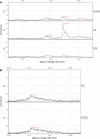The secretome of myocardial telocytes modulates the activity of cardiac stem cells
- PMID: 26176909
- PMCID: PMC4549029
- DOI: 10.1111/jcmm.12624
The secretome of myocardial telocytes modulates the activity of cardiac stem cells
Abstract
Telocytes (TCs) are interstitial cells that are present in numerous organs, including the heart interstitial space and cardiac stem cell niche. TCs are completely different from fibroblasts. TCs release extracellular vesicles that may interact with cardiac stem cells (CSCs) via paracrine effects. Data on the secretory profile of TCs and the bidirectional shuttle vesicular signalling mechanism between TCs and CSCs are scarce. We aimed to characterize and understand the in vitro effect of the TC secretome on CSC fate. Therefore, we studied the protein secretory profile using supernatants from mouse cultured cardiac TCs. We also performed a comparative secretome analysis using supernatants from rat cultured cardiac TCs, a pure CSC line and TCs-CSCs in co-culture using (i) high-sensitivity on-chip electrophoresis, (ii) surface-enhanced laser desorption/ionization time-of-flight mass spectrometry and (iii) multiplex analysis by Luminex-xMAP. We identified several highly expressed molecules in the mouse cardiac TC secretory profile: interleukin (IL)-6, VEGF, macrophage inflammatory protein 1α (MIP-1α), MIP-2 and MCP-1, which are also present in the proteome of rat cardiac TCs. In addition, rat cardiac TCs secrete a slightly greater number of cytokines, IL-2, IL-10, IL-13 and some chemokines like, GRO-KC. We found that VEGF, IL-6 and some chemokines (all stimulated by IL-6 signalling) are secreted by cardiac TCs and overexpressed in co-cultures with CSCs. The expression levels of MIP-2 and MIP-1α increased twofold and fourfold, respectively, when TCs were co-cultured with CSCs, while the expression of IL-2 did not significantly differ between TCs and CSCs in mono culture and significantly decreased (twofold) in the co-culture system. These data suggest that the TC secretome plays a modulatory role in stem cell proliferation and differentiation.
Keywords: Luminex-xMAP; SELDI-TOF; cardiac stem cells; chemokines; cytokines; fibroblasts; growth factors; telocytes.
© 2015 The Authors. Journal of Cellular and Molecular Medicine published by John Wiley & Sons Ltd and Foundation for Cellular and Molecular Medicine.
Figures






References
Publication types
MeSH terms
Substances
LinkOut - more resources
Full Text Sources
Other Literature Sources
Miscellaneous

